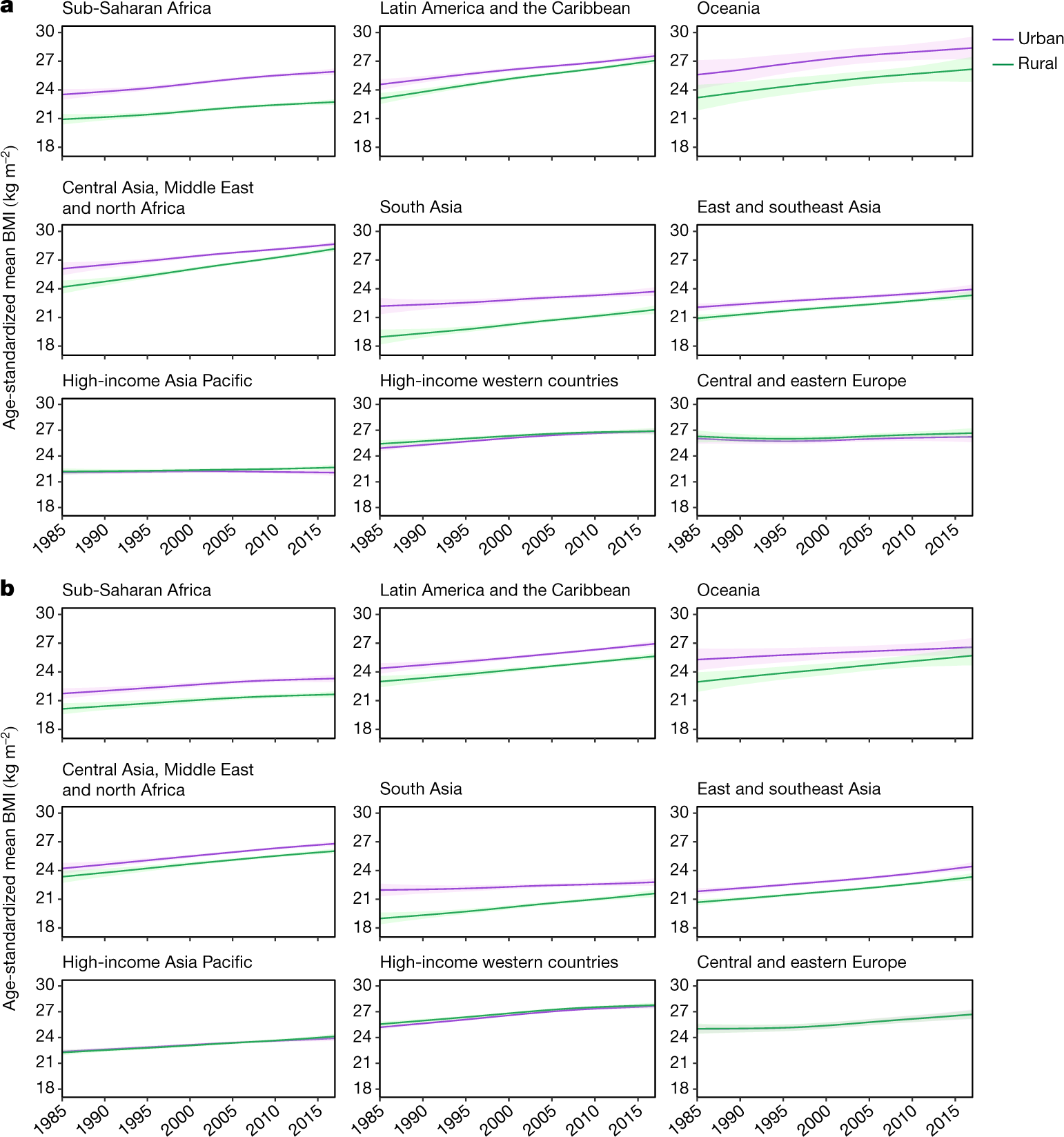文章信息:Honor Bixby, James Bentham, Bin Zhou, Mariachiara Di Cesare, Christopher J. Paciorek, James E. Bennett, Cristina Taddei, Gretchen A. Stevens, Andrea Rodriguez-Martinez, Rodrigo M. Carrillo-Larco, Young-Ho Khang, Maroje Sorić, Edward W. Gregg, J. Jaime Miranda, Zulfiqar A. Bhutta, Stefan Savin, Marisa K. Sophiea, Maria L. C. Iurilli, Bethlehem D. Solomon, … NCD Risk Factor Collaboration (NCD-RisC). (2019). Rising rural body-mass index is the main driver of the global obesity epidemic in adults. Nature: 569(7755), 260–264.https://doi.org/10.1038/s41586-019-1171-x
整理人:杨文,2023级硕士生
整理时间:2024年8月23日
Abstract: Body-mass index (BMI) has increased steadily in most countries in parallel with a rise in the proportion of the population who live in cities. This has led to a widely reported view that urbanization is one of the most important drivers of the global rise in obesity. Here we use 2,009 population-based studies, with measurements of height and weight in more than 112 million adults, to report national, regional and global trends in mean BMI segregated by place of residence (a rural or urban area) from 1985 to 2017. We show that, contrary to the dominant paradigm, more than 55% of the global rise in mean BMI from 1985 to 2017—and more than 80% in some low- and middle-income regions—was due to increases in BMI in rural areas. This large contribution stems from the fact that, with the exception of women in sub-Saharan Africa, BMI is increasing at the same rate or faster in rural areas than in cities in low- and middle-income regions. These trends have in turn resulted in a closing—and in some countries reversal—of the gap in BMI between urban and rural areas in low- and middle-income countries, especially for women. In high-income and industrialized countries, we noted a persistently higher rural BMI, especially for women. There is an urgent need for an integrated approach to rural nutrition that enhances financial and physical access to healthy foods, to avoid replacing the rural undernutrition disadvantage in poor countries with a more general malnutrition disadvantage that entails excessive consumption of low-quality calories.
摘要:在大多数国家,体重指数(BMI)稳步上升,与此同时,城市人口比例也在上升。这导致了一种广泛报道的观点,即城市化是全球肥胖率上升的最重要驱动因素之一。在这里,我们使用2009年基于人群的研究,对超过1.12亿成年人的身高和体重进行了测量,报告了1985年至2017年按居住地(农村或城市地区)划分的平均BMI的国家、地区和全球趋势。我们发现,与主流范式相反,从1985年到2017年,全球平均BMI上升的55%以上——在一些低收入和中等收入地区超过80%——是由于农村地区BMI的增加。这一巨大贡献源于这样一个事实,即除撒哈拉以南非洲地区的妇女外,农村地区的BMI增长速度与低收入和中等收入地区的城市相同或更快。这些趋势反过来又导致低收入和中等收入国家城市和农村地区,特别是妇女的BMI差距缩小,在一些国家甚至出现逆转。在高收入和工业化国家,我们注意到农村地区的BMI持续较高,尤其是女性。迫切需要采取综合办法解决农村营养问题,增加获得健康食品的经济和物质机会,以避免用更普遍的营养不良劣势取代贫穷国家农村营养不良的劣势,即过度消耗低质量的卡路里。

图 农村和城市女性年龄标准化平均BMI的差异
a、 1985年年龄标准化平均BMI的差异。b、 2017年年龄标准化平均BMI的差异。我们没有估计全部人口居住在城市(新加坡、香港、百慕大和瑙鲁)或农村(托克劳)地区的国家和领土的农村和城市地区之间的差异,以灰色显示。1985年和2017年全国以及农村和城市人口的平均BMI见图2。关于男女结果的比较。

图 按农村和城市居住地划分的年龄标准化平均BMI趋势
a、 显示了每个地区女性的趋势。b、 显示了每个地区男性的趋势。线条显示了后验均值估计,阴影区域显示了95%的可信区间。
原文链接:https://www.nature.com/articles/s41586-019-1171-x